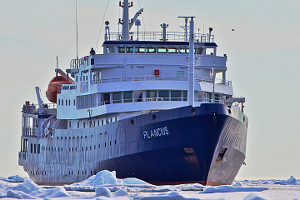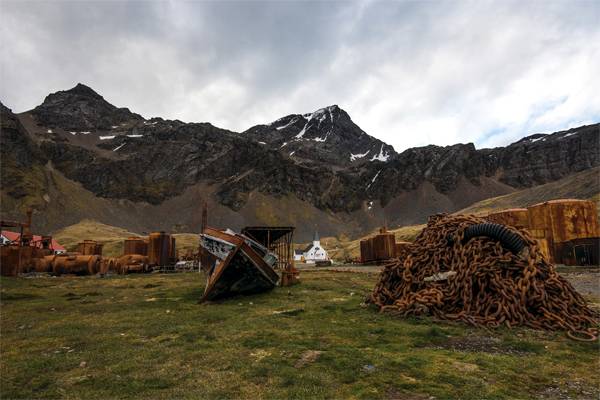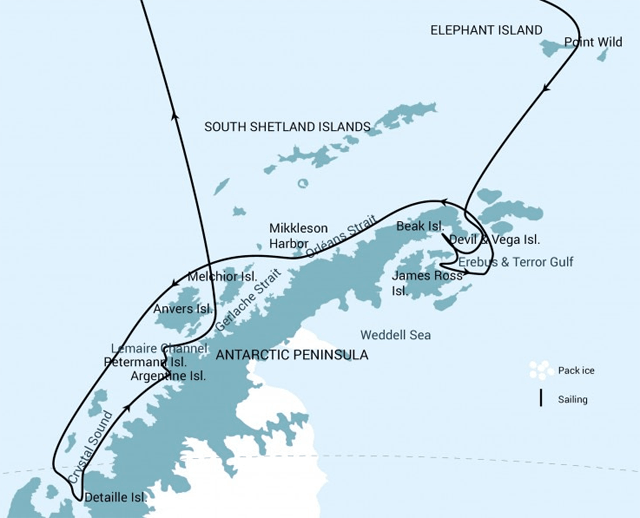HIGHLIGHTS
- Cross
the Antarctic Circle
- Sail
the exciting Weddell Sea
- Land
on the Antarctic Peninsula
- Visit
such iconic landing sites as Ernest Shackleton's legendary Elephant
Island
- Cruise
the icy and wildlife-filled islands of Crystal Sound
DATES / RATES
Rates are listed per person in USD
|
| Start Date | End Date | QUAD | TRIPLE | TWIN PORTHOLE | TWIN WINDOW | TWIN DELUXE | SUPERIOR |
|---|
| Mar 09, 2026 | Mar 23, 2026 | REQUEST | REQUEST | 14,300 | 14,950 | 16,450 | 17,300 |
Rates are listed per person in USD
|
| Start Date | End Date | (Starting from)
QUAD | (Mid-range)
TWIN WINDOW | (High-end)
SUPERIOR |
|---|
| Mar 09, 2026 | Mar 23, 2026 | REQUEST | 14,950 | 17,300 |
ITINERARY
Day
1: End of the world, start of a journey
Your
voyage begins where the world drops off. Ushuaia, Argentina, reputed to
be the southernmost city on the planet, is located on the far southern
tip of South America. Starting in the afternoon, you embark from this
small resort town on Tierra del Fuego, nicknamed “The End of
the World,” and sail the mountain-fringed Beagle Channel for
the remainder of the evening.
Day
2 – 3: Path of the polar explorers
Over
the next two days on the Drake Passage, you enjoy some of the same
experiences encountered by the great polar explorers who first charted
these regions: cool salt breezes, rolling seas, maybe even a fin whale
spouting up sea spray. After passing the Antarctic Convergence
– Antarctica’s natural boundary, formed when
north-flowing cold waters collide with warmer sub-Antarctic seas
– you are in the circum-Antarctic upwelling zone.
Not
only does the marine life change, the avian life changes too. Wandering
albatrosses, grey-headed albatrosses, black-browed albatrosses,
light-mantled sooty albatrosses, cape pigeons, southern fulmars,
Wilson’s storm petrels, blue petrels, and Antarctic petrels
are a few of the birds you might see.
Day
4: From Point Wild to the Weddell Sea
We
will arrive early to the famous Point Wild, Elephant Island, where
Shackleton’s crew made their first landing after the loss of
their ship, Endurance. This inhospitable spit of land is a favorite
among our guests, and if conditions permit, we will offer activities
around the point before setting off for the Weddell Sea.
Day
5: Weddell Sea Devil Island
Today
you enter the wondrous Weddell Sea, a relatively unvisited area in
which we hope to carry out activities in Erebus and Terror Gulf. We may
also visit such places such as Beak Island and Devil Island, which
boast some stunning scenery as well as the pack ice for which the
Weddell Sea is famous.
Day
6: Exploring the most remote regions
As
we continue to explore the area of Erebus and Terror Gulf, we look for
new opportunities for activities. You may also visit Vega Island,
experiencing the wilderness of Antarctica in its most remote places.
Day
7: Orléans Strait whale search
Now
we sail down the western side of the Antarctic Peninsula, entering the
Orleans Strait. Here we hope to see humpback and orca whales as we sail
toward Mikklesen Harbor for our afternoon activities.
Day
8: Port monuments and island wildlife
Passing
the Lemaire Channel, you next arrive in the area of Port Charcot, where
there is a cairn that was erected by the French Antarctic Expedition of
1903 – 05. In the afternoon, we head to Petermann Island to
see a great variety of birdlife. You might also enjoy Zodiac cruises
among icebergs that are highly popular with leopard seals and crabeater
seals. Minke whales, humpbacks, and gentoo penguins can also be found
here.
Day
9 - 10: Detaille Island’s historic station
Today
we reach Crystal Sound, viewing the area’s beautiful ice
formations and wildlife before landing at Detaille Island. This remote
island was once home to a British research station that is now an
historic monument.
Day
11: Amazing Argentine islands
Next
you arrive at the Yalour Islands, a small archipelago composed mostly
of isolated rocks and one principal island that offers us a rewarding
landing. Home to Adélie penguins and some of the most
southerly gentoos in the world, Yalour also has small patches of
bearded and crustose lichen, including xanthoria, buellia, caloplaca,
and usnea. Extensive moss beds and some Antarctic hair grass
(Deschampsia antarctica) can be seen as well.
Day
12: Farewell to Antarctica
We
have our farewell to Antarctica in the Melchior Islands for our final
activities before heading towards the Drake Passage.
Day
13 – 14: Familiar seas, familiar friends
Your
return voyage is far from lonely. While crossing the Drake,
you’re again greeted by the vast array of seabirds remembered
from the passage south. But they seem a little more familiar to you
now, and you to them.
Day
15: There and back again
Every
adventure, no matter how great, must eventually come to an end.
It’s now time to disembark in Ushuaia, but with memories that
will accompany you wherever your next journey leads.
Plancius (Expedition, 108-guests)
MV Plancius offers a restaurant/lecture room on deck 3 and a spacious observation lounge (with bar) on deck 5 with large windows, offering full panorama view. The vessel has large open deck spaces (with full walk-around possibilities on deck 4), giving excellent opportunities to enjoy the scenery and wildlife. She is furthermore equipped with 10 Mark V zodiacs.
 (Click image to view Ship details)
(Click image to view Ship details)
WHAT'S INCLUDED
- Voyage
aboard the indicated vessel as indicated in the itinerary
- All
meals throughout the voyage aboard the ship including snacks, coffee
and tea.
- All
shore excursions and activities throughout the voyage by Zodiac.
- Program
of lectures by noted naturalists and leadership by experienced
expedition staff.
- Free
use of rubber boots and snowshoes.
- Luggage
transfer from pick-up point to the vessel on the day of embarkation, in
Ushuaia.
- Pre-scheduled
group transfer from the vessel to the airport in Ushuaia (directly
after disembarkation).
- All
miscellaneous service taxes and port charges throughout the programme.
- Comprehensive
pre-departure material.
Excluded
from this voyage
- Any
airfare, whether on scheduled or charter flights
- Pre-
and post- land arrangements.
- Passport
and visa expenses.
- Government
arrival and departure taxes.
- Meals
ashore.
- Baggage,
cancellation and personal insurance (which is strongly recommended).
- Excess
baggage charges and all items of a personal nature such as laundry,
bar, beverage charges and telecommunication charges.
- The
customary gratuity at the end of the voyages for stewards and other
service personnel aboard (guidelines will be provided).
ADVENTURE OPTIONS - Kayaking: 550 USD
- Photo Workshop: FREE
- Snowshoeing: FREE






